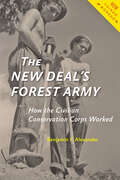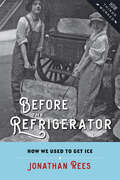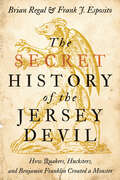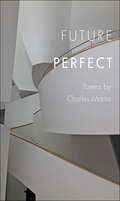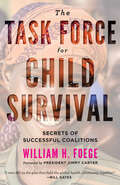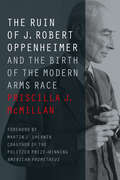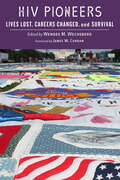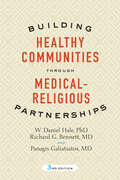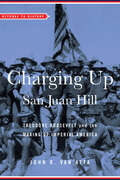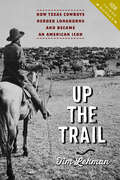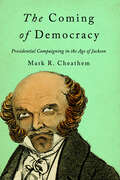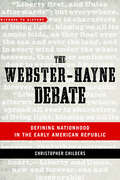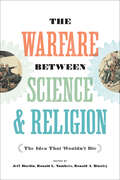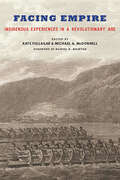- Table View
- List View
The New Deal's Forest Army: How the Civilian Conservation Corps Worked (How Things Worked)
by Benjamin F. AlexanderPropelled by the unprecedented poverty of the Great Depression, President Franklin D. Roosevelt established an array of massive public works programs designed to provide direct relief to America;€™s poor and unemployed. The New Deal;€™s most tangible legacy may be the Civilian Conservation Corps;€™s network of parks, national forests, scenic roadways, and picnic shelters that still mark the country;€™s landscape. CCC enrollees, most of them unmarried young men, lived in camps run by the Army and worked hard for wages (most of which they had to send home to their families) to preserve America;€™s natural treasures. In The New Deal;€™s Forest Army, Benjamin F. Alexander chronicles how the corps came about, the process applicants went through to get in, and what jobs they actually did. He also explains how the camps and the work sites were run, how enrollees spent their leisure time, and how World War II brought the CCC to its end. Connecting the story of the CCC with the Roosevelt administration;€™s larger initiatives, Alexander describes how FDR;€™s policies constituted a mixed blessing for African Americans who, even while singled out for harsh treatment, benefited enough from the New Deal to become an increasingly strong part of the electorate behind the Democratic Party. The CCC was the only large-scale employment program whose existence FDR foreshadowed in speeches during the 1932 campaign;¢;‚¬;€?and the dearest to his heart throughout the decade that it lasted. Alexander reveals how the work itself left a lasting imprint on the country;€™s terrain as the enrollees planted trees, fought forest fires, landscaped public parks, restored historic battlegrounds, and constructed dams and terraces to prevent floods. A uniquely detailed exploration of life in the CCC, The New Deal;€™s Forest Army compellingly demonstrates how one New Deal program changed America and gave birth to both contemporary forestry and the modern environmental movement.
The New Deal's Forest Army: How the Civilian Conservation Corps Worked (How Things Worked)
by Benjamin F. AlexanderPropelled by the unprecedented poverty of the Great Depression, President Franklin D. Roosevelt established an array of massive public works programs designed to provide direct relief to America;€™s poor and unemployed. The New Deal;€™s most tangible legacy may be the Civilian Conservation Corps;€™s network of parks, national forests, scenic roadways, and picnic shelters that still mark the country;€™s landscape. CCC enrollees, most of them unmarried young men, lived in camps run by the Army and worked hard for wages (most of which they had to send home to their families) to preserve America;€™s natural treasures. In The New Deal;€™s Forest Army, Benjamin F. Alexander chronicles how the corps came about, the process applicants went through to get in, and what jobs they actually did. He also explains how the camps and the work sites were run, how enrollees spent their leisure time, and how World War II brought the CCC to its end. Connecting the story of the CCC with the Roosevelt administration;€™s larger initiatives, Alexander describes how FDR;€™s policies constituted a mixed blessing for African Americans who, even while singled out for harsh treatment, benefited enough from the New Deal to become an increasingly strong part of the electorate behind the Democratic Party. The CCC was the only large-scale employment program whose existence FDR foreshadowed in speeches during the 1932 campaign;¢;‚¬;€?and the dearest to his heart throughout the decade that it lasted. Alexander reveals how the work itself left a lasting imprint on the country;€™s terrain as the enrollees planted trees, fought forest fires, landscaped public parks, restored historic battlegrounds, and constructed dams and terraces to prevent floods. A uniquely detailed exploration of life in the CCC, The New Deal;€™s Forest Army compellingly demonstrates how one New Deal program changed America and gave birth to both contemporary forestry and the modern environmental movement.
Before the Refrigerator: How We Used to Get Ice (How Things Worked)
by Jonathan ReesDuring the late nineteenth and early twentieth centuries, Americans depended upon ice to stay cool and to keep their perishable foods fresh. Jonathan Rees tells the fascinating story of how people got ice before mechanical refrigeration came to the household. Drawing on newspapers, trade journals, and household advice books, Before the Refrigerator explains how Americans built a complex system to harvest, store, and transport ice to everyone who wanted it, even the very poor.Rees traces the evolution of the natural ice industry from its mechanization in the 1880s through its gradual collapse, which started after World War I. Meatpackers began experimenting with ice refrigeration to ship their products as early as the 1860s. Starting around 1890, large, bulky ice machines the size of small houses appeared on the scene, becoming an important source for the American ice supply. As ice machines shrunk, more people had access to better ice for a wide variety of purposes. By the early twentieth century, Rees writes, ice had become an essential tool for preserving perishable foods of all kinds, transforming what most people ate and drank every day. Reviewing all the inventions that made the ice industry possible and the way they worked together to prevent ice from melting, Rees demonstrates how technological systems can operate without a central controlling force. Before the Refrigerator is ideal for history of technology classes, food studies classes, or anyone interested in what daily life in the United States was like between 1880 and 1930.
Before the Refrigerator: How We Used to Get Ice (How Things Worked)
by Jonathan ReesDuring the late nineteenth and early twentieth centuries, Americans depended upon ice to stay cool and to keep their perishable foods fresh. Jonathan Rees tells the fascinating story of how people got ice before mechanical refrigeration came to the household. Drawing on newspapers, trade journals, and household advice books, Before the Refrigerator explains how Americans built a complex system to harvest, store, and transport ice to everyone who wanted it, even the very poor.Rees traces the evolution of the natural ice industry from its mechanization in the 1880s through its gradual collapse, which started after World War I. Meatpackers began experimenting with ice refrigeration to ship their products as early as the 1860s. Starting around 1890, large, bulky ice machines the size of small houses appeared on the scene, becoming an important source for the American ice supply. As ice machines shrunk, more people had access to better ice for a wide variety of purposes. By the early twentieth century, Rees writes, ice had become an essential tool for preserving perishable foods of all kinds, transforming what most people ate and drank every day. Reviewing all the inventions that made the ice industry possible and the way they worked together to prevent ice from melting, Rees demonstrates how technological systems can operate without a central controlling force. Before the Refrigerator is ideal for history of technology classes, food studies classes, or anyone interested in what daily life in the United States was like between 1880 and 1930.
The Secret History of the Jersey Devil: How Quakers, Hucksters, and Benjamin Franklin Created a Monster
by Brian Regal Frank J. EspositoLegend has it that in 1735 a witch named Mother Leeds gave birth to a horrifying monster;¢;‚¬;€?a deformed flying horse with glowing red eyes;¢;‚¬;€?that flew up the chimney of her New Jersey home and disappeared into the Pine Barrens. Ever since, this nightmarish beast has haunted those woods, presaging catastrophe and frightening innocent passersby;¢;‚¬;€?or so the story goes. In The Secret History of the Jersey Devil, Brian Regal and Frank J. Esposito examine the genesis of this popular myth, which is one of the oldest monster legends in the United States.According to Regal and Esposito, everything you think you know about the Jersey Devil is wrong. The real story of the Jersey Devil's birth is far more interesting, complex, and important than most people;¢;‚¬;€?believers and skeptics alike;¢;‚¬;€?realize. Leaving the Pine Barrens, Regal and Esposito turn instead to the varied political and cultural roots of the Devil's creation. Fascinating and lively, this book finds the origins of New Jersey's favorite monster not in witchcraft or an unnatural liaison between woman and devil but in the bare-knuckled political fights and religious upheavals of colonial America. A product of innuendo and rumor, as well as scandal and media hype, the Jersey Devil enjoys a rich history involving land grabs, astrological predictions, mermaids and dinosaur bones, sideshows, Napoleon Bonaparte's brother, a cross-dressing royal governor, and Founding Father Benjamin Franklin.
The Secret History of the Jersey Devil: How Quakers, Hucksters, and Benjamin Franklin Created a Monster
by Brian Regal Frank J. EspositoLegend has it that in 1735 a witch named Mother Leeds gave birth to a horrifying monster;¢;‚¬;€?a deformed flying horse with glowing red eyes;¢;‚¬;€?that flew up the chimney of her New Jersey home and disappeared into the Pine Barrens. Ever since, this nightmarish beast has haunted those woods, presaging catastrophe and frightening innocent passersby;¢;‚¬;€?or so the story goes. In The Secret History of the Jersey Devil, Brian Regal and Frank J. Esposito examine the genesis of this popular myth, which is one of the oldest monster legends in the United States.According to Regal and Esposito, everything you think you know about the Jersey Devil is wrong. The real story of the Jersey Devil's birth is far more interesting, complex, and important than most people;¢;‚¬;€?believers and skeptics alike;¢;‚¬;€?realize. Leaving the Pine Barrens, Regal and Esposito turn instead to the varied political and cultural roots of the Devil's creation. Fascinating and lively, this book finds the origins of New Jersey's favorite monster not in witchcraft or an unnatural liaison between woman and devil but in the bare-knuckled political fights and religious upheavals of colonial America. A product of innuendo and rumor, as well as scandal and media hype, the Jersey Devil enjoys a rich history involving land grabs, astrological predictions, mermaids and dinosaur bones, sideshows, Napoleon Bonaparte's brother, a cross-dressing royal governor, and Founding Father Benjamin Franklin.
Future Perfect (Johns Hopkins: Poetry and Fiction)
by Charles MartinTo be modern is to live not in a single era, but in a churn of new technologies, deep history, myth, literary traditions, and contemporary cultural memes. In Future Perfect, Charles Martin;€™s darkly comic new collection, the poet explores our time and the times that come before and after, which we inhabit and cultivate in memory and imagination. Through poems that play with form and challenge expectation, Martin examines the continuities that persist from time immemorial to the future perfect.Sensitive to the traces left behind by the lives of his characters, Martin follows their tracks, reflections, echoes, and shadows. In "From Certain Footprints Found at Laetoli," an ancient impression preserved in volcanic ash conjures up a family scene three million years past. In "The Last Resort of Mr. Kees" and "Mr. Kees Goes to a Party," Martin adopts the persona of the vanished poet Weldon Kees to reimagine his disappearance. "Letter from Komarovo, 1962" retells the tense real-life meeting between Anna Akhmatova and Robert Frost a year before their nations almost destroyed one another. And in the titular sonnet sequence that ends the book, Martin conjures a childhood in the Bronx under the shadow of the mushroom cloud of nuclear war as the perfected future supplanting the present.Introducing Buck Rogers to Randall Jarrell and combining new translations or reinterpretations of works by Ovid, G. G. Belli, Octavio Paz, and Euripides, Future Perfect further establishes Charles Martin as a master of invention.
Future Perfect (Johns Hopkins: Poetry and Fiction)
by Charles MartinTo be modern is to live not in a single era, but in a churn of new technologies, deep history, myth, literary traditions, and contemporary cultural memes. In Future Perfect, Charles Martin;€™s darkly comic new collection, the poet explores our time and the times that come before and after, which we inhabit and cultivate in memory and imagination. Through poems that play with form and challenge expectation, Martin examines the continuities that persist from time immemorial to the future perfect.Sensitive to the traces left behind by the lives of his characters, Martin follows their tracks, reflections, echoes, and shadows. In "From Certain Footprints Found at Laetoli," an ancient impression preserved in volcanic ash conjures up a family scene three million years past. In "The Last Resort of Mr. Kees" and "Mr. Kees Goes to a Party," Martin adopts the persona of the vanished poet Weldon Kees to reimagine his disappearance. "Letter from Komarovo, 1962" retells the tense real-life meeting between Anna Akhmatova and Robert Frost a year before their nations almost destroyed one another. And in the titular sonnet sequence that ends the book, Martin conjures a childhood in the Bronx under the shadow of the mushroom cloud of nuclear war as the perfected future supplanting the present.Introducing Buck Rogers to Randall Jarrell and combining new translations or reinterpretations of works by Ovid, G. G. Belli, Octavio Paz, and Euripides, Future Perfect further establishes Charles Martin as a master of invention.
The Task Force for Child Survival: Secrets of Successful Coalitions
by William W. FoegeDr. Bill Foege, one of the best-known names in global health, brings readers to the table during the creation of one of the world;€™s most famous and successful global health efforts;¢;‚¬;€?the Task Force for Child Survival.In 1984, the US immunization program was so successful that many childhood diseases were at record lows;¢;‚¬;€?yet 40,000 children a day were dying around the world from preventable diseases. That year, Dr. Foege, former director of the Centers for Disease Control and Prevention, came together with Jonas Salk, Robert McNamara, and representatives from UNICEF, the World Health Organization, the World Bank, the United Nations Development Programme, and the Rockefeller Foundation to see how some of the lessons learned in America could be applied to global programs. The assembled participants recommended the formation of a small task force to help UN agencies improve immunization coverage. They dubbed it the Task Force for Child Survival and installed Foege as its first leader.In this book, Dr. Foege describes the task force from its conception through its landmark success. Over its first six years, as more resources were allocated to the task force, immunization coverage climbed from approximately 15 percent of the world;€™s children for some vaccines to 80 percent of the world;€™s children for at least one vaccine. UNICEF head Jim Grant called it the greatest peacetime endeavor the world had ever seen. How did this small, independent, low-profile group leverage change in the largest of global health agencies? Foege dissects each element for clues as to why the task force was able to accomplish so much so quickly, ultimately concluding that coalition-building played a major role and explaining how to strengthen coalitions by scrupulously avoiding the turf guarding and credit seeking that are so common to international endeavors.Inspiring and accessible, this brief book combines the distilled advice of one of global health's major leaders with the history of an iconic public health program.
The Task Force for Child Survival: Secrets of Successful Coalitions
by William W. FoegeDr. Bill Foege, one of the best-known names in global health, brings readers to the table during the creation of one of the world;€™s most famous and successful global health efforts;¢;‚¬;€?the Task Force for Child Survival.In 1984, the US immunization program was so successful that many childhood diseases were at record lows;¢;‚¬;€?yet 40,000 children a day were dying around the world from preventable diseases. That year, Dr. Foege, former director of the Centers for Disease Control and Prevention, came together with Jonas Salk, Robert McNamara, and representatives from UNICEF, the World Health Organization, the World Bank, the United Nations Development Programme, and the Rockefeller Foundation to see how some of the lessons learned in America could be applied to global programs. The assembled participants recommended the formation of a small task force to help UN agencies improve immunization coverage. They dubbed it the Task Force for Child Survival and installed Foege as its first leader.In this book, Dr. Foege describes the task force from its conception through its landmark success. Over its first six years, as more resources were allocated to the task force, immunization coverage climbed from approximately 15 percent of the world;€™s children for some vaccines to 80 percent of the world;€™s children for at least one vaccine. UNICEF head Jim Grant called it the greatest peacetime endeavor the world had ever seen. How did this small, independent, low-profile group leverage change in the largest of global health agencies? Foege dissects each element for clues as to why the task force was able to accomplish so much so quickly, ultimately concluding that coalition-building played a major role and explaining how to strengthen coalitions by scrupulously avoiding the turf guarding and credit seeking that are so common to international endeavors.Inspiring and accessible, this brief book combines the distilled advice of one of global health's major leaders with the history of an iconic public health program.
The Ruin of J. Robert Oppenheimer: And the Birth of the Modern Arms Race (Johns Hopkins Nuclear History and Contemporary Affairs)
by Priscilla J. McMillanOn April 12, 1954, the nation was astonished to learn that J. Robert Oppenheimer was facing charges of violating national security. Could the director of the Manhattan Project, the visionary who led the effort to build the atom bomb, really be a traitor? In this riveting book, bestselling author Priscilla J. McMillan draws on newly declassified U.S. government documents and materials from Russia, as well as in-depth interviews, to expose for the first time the conspiracy that destroyed one of America;€™s most illustrious scientists.McMillan recreates the fraught years from 1949 to 1955 when Oppenheimer and a group of liberal scientists tried to head off the cabal of hard-line air force officials, anti-Communist politicians, and rival scientists, including physicist Edward Teller, who were trying to seize control of U.S. policy and build ever more deadly nuclear weapons. Retelling the story of Oppenheimer;€™s trial, which took place in utmost secrecy, she describes how the government made up its own rules and violated many protections of the rule of law. She also argues that the effort to discredit Oppenheimer, occurring at the height of the McCarthy era and sanctioned by a misinformed President Eisenhower, was a watershed in the Cold War, poisoning American politics for decades and creating dangers that haunt us today.A chilling tale of McCarthy-era machinations, this groundbreaking page-turner rewrites the history of the Cold War.
HIV Pioneers: Lives Lost, Careers Changed, and Survival
by Wendee M. Wechsberg James W. CurranTremendous strides have been made in the prevention and treatment of HIV since the disease first appeared in the 1980s. But because many of the people who studied and battled the virus in those early days are now gone, firsthand accounts are at risk of being lost. In HIV Pioneers, Wendee M. Wechsberg collects 29 "first stories" from the outset of the AIDS epidemic. These moving personal narratives and critical historical essays not only shed light on the experiences of global health pioneers, prominent scientists, and HIV survivors, but also preserve valuable lessons for managing the risk and impact of future epidemics.With unprecedented access to many key actors in the fight against AIDS and HIV, Wechsberg brings to life the harrowing reality of those early days of the epidemic. The book captures the experiences of those still working diligently and innovatively in the field, elevating the voices of doctors, scientists, and government bureaucrats alongside those of survivors and their loved ones. Focusing on the impact that the epidemic had on careers, pieces also show how governments responded to HIV, how research agendas were developed, and how AIDS service agencies and case management evolved.Illuminating the multiple facets of the HIV epidemic, both in the United States and across the globe, HIV Pioneers is a touching and inspirational look into the ongoing fight against HIV.Contributors: Quarraisha Abdool Karim, Salim S. Abdool Karim, Lynda Arnold, Anne Jeanene Bengoa, Robert E. Booth, Barry S. Brown, Thomas Coates, Francine Cournos, James W. Curran, Don C. Des Jarlais, Jeffrey D. Fisher, William A. Fisher, Samuel R. Friedman, Robert C. Gallo, Mary Guinan, Gibbie Harris, Warren W. Hewitt Jr., Susan M. Kegeles, Rayford Kytle, Bishop Stacey S. Latimer, Robert Love, Duane C. McBride, Clyde B. McCoy, Carmen Morris, Willo Pequegnat, Mary Jane Rotheram-Borus, Jeffrey Samet, David Serwadda, Lorraine Sherr, James L. Sorensen, Jack B. Stein, Charles van der Horst, Wendee M. Wechsberg, Wayne Wiebel, William A. Zule
HIV Pioneers: Lives Lost, Careers Changed, and Survival
by Wendee M. Wechsberg James W. CurranTremendous strides have been made in the prevention and treatment of HIV since the disease first appeared in the 1980s. But because many of the people who studied and battled the virus in those early days are now gone, firsthand accounts are at risk of being lost. In HIV Pioneers, Wendee M. Wechsberg collects 29 "first stories" from the outset of the AIDS epidemic. These moving personal narratives and critical historical essays not only shed light on the experiences of global health pioneers, prominent scientists, and HIV survivors, but also preserve valuable lessons for managing the risk and impact of future epidemics.With unprecedented access to many key actors in the fight against AIDS and HIV, Wechsberg brings to life the harrowing reality of those early days of the epidemic. The book captures the experiences of those still working diligently and innovatively in the field, elevating the voices of doctors, scientists, and government bureaucrats alongside those of survivors and their loved ones. Focusing on the impact that the epidemic had on careers, pieces also show how governments responded to HIV, how research agendas were developed, and how AIDS service agencies and case management evolved.Illuminating the multiple facets of the HIV epidemic, both in the United States and across the globe, HIV Pioneers is a touching and inspirational look into the ongoing fight against HIV.Contributors: Quarraisha Abdool Karim, Salim S. Abdool Karim, Lynda Arnold, Anne Jeanene Bengoa, Robert E. Booth, Barry S. Brown, Thomas Coates, Francine Cournos, James W. Curran, Don C. Des Jarlais, Jeffrey D. Fisher, William A. Fisher, Samuel R. Friedman, Robert C. Gallo, Mary Guinan, Gibbie Harris, Warren W. Hewitt Jr., Susan M. Kegeles, Rayford Kytle, Bishop Stacey S. Latimer, Robert Love, Duane C. McBride, Clyde B. McCoy, Carmen Morris, Willo Pequegnat, Mary Jane Rotheram-Borus, Jeffrey Samet, David Serwadda, Lorraine Sherr, James L. Sorensen, Jack B. Stein, Charles van der Horst, Wendee M. Wechsberg, Wayne Wiebel, William A. Zule
Building Healthy Communities through Medical-Religious Partnerships
by W. Daniel Hale Richard G. Bennett Panagis GaliatsatosBecause health care works best when patients assume greater responsibility for their own health, community outreach and patient education are essential. But where can health care organizations find the resources to educate large numbers of people about chronic diseases? How can they tailor programs to meet the needs of increasingly diverse communities? And how can they reach people who have no ties to the health care system? Building Healthy Communities through Medical-Religious Partnerships presents an innovative approach to community-based health education and patient advocacy programs targeted at the prevention and management of disease. Offering valuable guidance for religious and medical leaders interested in developing programs in their congregations and communities, the book includes practical and accessible information for establishing health education programs, identifies additional resources that can be obtained from local and national organizations, and discusses a range of medical topics. It also outlines how to train volunteers to assist others in navigating our complex health system. This latest edition, which has been thoroughly revised and updated, incorporates;€¢ new chapters on medical topics across the lifespan, including lung disease, kidney disease, and child and adolescent health issues;;€¢ a thorough assessment of medical-religious partnerships that have emerged over the past twenty-five years; and;€¢ a user-friendly website with downloadable resources;¢;‚¬;€?including an instructor's guide, PowerPoint slides, and ready-made handouts.
Building Healthy Communities through Medical-Religious Partnerships
by W. Daniel Hale Richard G. Bennett Panagis GaliatsatosBecause health care works best when patients assume greater responsibility for their own health, community outreach and patient education are essential. But where can health care organizations find the resources to educate large numbers of people about chronic diseases? How can they tailor programs to meet the needs of increasingly diverse communities? And how can they reach people who have no ties to the health care system? Building Healthy Communities through Medical-Religious Partnerships presents an innovative approach to community-based health education and patient advocacy programs targeted at the prevention and management of disease. Offering valuable guidance for religious and medical leaders interested in developing programs in their congregations and communities, the book includes practical and accessible information for establishing health education programs, identifies additional resources that can be obtained from local and national organizations, and discusses a range of medical topics. It also outlines how to train volunteers to assist others in navigating our complex health system. This latest edition, which has been thoroughly revised and updated, incorporates;€¢ new chapters on medical topics across the lifespan, including lung disease, kidney disease, and child and adolescent health issues;;€¢ a thorough assessment of medical-religious partnerships that have emerged over the past twenty-five years; and;€¢ a user-friendly website with downloadable resources;¢;‚¬;€?including an instructor's guide, PowerPoint slides, and ready-made handouts.
Charging Up San Juan Hill: Theodore Roosevelt and the Making of Imperial America (Witness to History)
by John R. Van AttaBelow a Cuban sun so hot it stung their eyes, American troops hunkered low at the base of Kettle Hill. Spanish bullets zipped overhead, while enemy artillery shells landed all around them. Driving Spanish forces from the high ground would mean gaining control of Santiago, Cuba, and, soon enough, American victory in the Spanish-American War. No one doubted that enemy fire would claim a heavy toll, but these unusual citizen-soldiers and their unlikely commander;¢;‚¬;€?39-year-old Colonel Theodore Roosevelt;¢;‚¬;€?had volunteered for exactly this kind of mission.In Charging Up San Juan Hill, John R. Van Atta recounts that fateful day in 1898. Describing the battle;€™s background and its ramifications for Roosevelt, both personal and political, Van Atta explains how Roosevelt;€™s wartime experience prompted him to champion American involvement in world affairs. Tracking Roosevelt;€™s rise to the presidency, this book argues that the global expansion of American influence;¢;‚¬;€?indeed, the building of an empire outward from a strengthened core of shared values at home;¢;‚¬;€?connected to the broader question of cultural sustainability as much as it did to the increasing of trade, political power, and military might.At the turn of the twentieth century, Theodore Roosevelt personified American confidence. A New York City native and recovered asthmatic who spent his twenties in the wilds of the Dakota Territory, Roosevelt leapt into the war with Spain with gusto. He organized a band of cavalry volunteers he called the Rough Riders and, on July 1, 1898, took part in their charge up a Cuban hill the newspapers called San Juan, launching him to national prominence. Without San Juan, Van Atta argues, Roosevelt;¢;‚¬;€?whom the papers credited for the victory and lauded as a paragon of manhood;¢;‚¬;€?would never have reached a position to become president.
Charging Up San Juan Hill: Theodore Roosevelt and the Making of Imperial America (Witness to History)
by John R. Van AttaBelow a Cuban sun so hot it stung their eyes, American troops hunkered low at the base of Kettle Hill. Spanish bullets zipped overhead, while enemy artillery shells landed all around them. Driving Spanish forces from the high ground would mean gaining control of Santiago, Cuba, and, soon enough, American victory in the Spanish-American War. No one doubted that enemy fire would claim a heavy toll, but these unusual citizen-soldiers and their unlikely commander;¢;‚¬;€?39-year-old Colonel Theodore Roosevelt;¢;‚¬;€?had volunteered for exactly this kind of mission.In Charging Up San Juan Hill, John R. Van Atta recounts that fateful day in 1898. Describing the battle;€™s background and its ramifications for Roosevelt, both personal and political, Van Atta explains how Roosevelt;€™s wartime experience prompted him to champion American involvement in world affairs. Tracking Roosevelt;€™s rise to the presidency, this book argues that the global expansion of American influence;¢;‚¬;€?indeed, the building of an empire outward from a strengthened core of shared values at home;¢;‚¬;€?connected to the broader question of cultural sustainability as much as it did to the increasing of trade, political power, and military might.At the turn of the twentieth century, Theodore Roosevelt personified American confidence. A New York City native and recovered asthmatic who spent his twenties in the wilds of the Dakota Territory, Roosevelt leapt into the war with Spain with gusto. He organized a band of cavalry volunteers he called the Rough Riders and, on July 1, 1898, took part in their charge up a Cuban hill the newspapers called San Juan, launching him to national prominence. Without San Juan, Van Atta argues, Roosevelt;¢;‚¬;€?whom the papers credited for the victory and lauded as a paragon of manhood;¢;‚¬;€?would never have reached a position to become president.
Up the Trail: How Texas Cowboys Herded Longhorns and Became an American Icon (How Things Worked)
by Tim LehmanCattle drives were the largest, longest, and ultimately the last of the great forced animal migrations in human history. Spilling out of Texas, they spread longhorns, cowboys, and the culture that roped the two together throughout the American West. In cities like Abilene, Dodge City, and Wichita, buyers paid off ranchers, ranchers paid off wranglers, and railroad lines took the cattle east to the packing plants of St. Louis and Chicago. The cattle drives of our imagination are filled with colorful cowboys prodding and coaxing a line of bellowing animals along a dusty path through the wilderness. These sturdy cowhands always triumph over stampedes, swollen rivers, and bloodthirsty Indians to deliver their mighty-horned companions to market;¢;‚¬;€?but Tim Lehman;€™s Up the Trail reveals that the gritty reality was vastly different. Far from being rugged individualists, the actual cow herders were itinerant laborers;¢;‚¬;€?a proletariat on horseback who connected cattle from the remote prairies of Texas with the nation;€™s industrial slaughterhouses. Lehman demystifies the cowboy life by describing the origins of the cattle drive and the extensive planning, complicated logistics, great skill, and good luck essential to getting the cows to market. He reveals how drives figured into the larger story of postwar economic development and traces the complex effects the cattle business had on the environment. He also explores how the premodern cowboy became a national hero who personified the manly virtues of rugged individualism and personal independence. Grounded in primary sources, this absorbing book takes advantage of recent scholarship on labor, race, gender, and the environment. The lively narrative will appeal to students of Texas and western history as well as anyone interested in cowboy culture.
The Coming of Democracy: Presidential Campaigning in the Age of Jackson
by Mark R. CheathemAfter the "corrupt bargain" that awarded John Quincy Adams the presidency in 1825, American politics underwent a fundamental shift from deference to participation. This changing tide eventually propelled Andrew Jackson into the White House;¢;‚¬;€?twice. But the presidential race that best demonstrated the extent of the changes was that of Martin Van Buren and war hero William Henry Harrison in 1840. Harrison;€™s campaign was famously marked by sloganeering and spirited rallies. In The Coming of Democracy, Mark R. Cheathem examines the evolution of presidential campaigning from 1824 to 1840. Addressing the roots of early republic cultural politics;¢;‚¬;€?from campaign biographies to songs, political cartoons, and public correspondence between candidates and voters;¢;‚¬;€?Cheathem asks the reader to consider why such informal political expressions increased so dramatically during the Jacksonian period. What sounded and looked like mere entertainment, he argues, held important political meaning. The extraordinary voter participation rate;¢;‚¬;€?over 80 percent;¢;‚¬;€?in the 1840 presidential election indicated that both substantive issues and cultural politics drew Americans into the presidential selection process.Drawing on period newspapers, diaries, memoirs, and public and private correspondence, The Coming of Democracy is the first book-length treatment to reveal how presidents and presidential candidates used both old and new forms of cultural politics to woo voters and win elections in the Jacksonian era. This book will appeal to anyone interested in US politics, the Jacksonian/antebellum era, or the presidency.
The Coming of Democracy: Presidential Campaigning in the Age of Jackson
by Mark R. CheathemAfter the "corrupt bargain" that awarded John Quincy Adams the presidency in 1825, American politics underwent a fundamental shift from deference to participation. This changing tide eventually propelled Andrew Jackson into the White House;¢;‚¬;€?twice. But the presidential race that best demonstrated the extent of the changes was that of Martin Van Buren and war hero William Henry Harrison in 1840. Harrison;€™s campaign was famously marked by sloganeering and spirited rallies. In The Coming of Democracy, Mark R. Cheathem examines the evolution of presidential campaigning from 1824 to 1840. Addressing the roots of early republic cultural politics;¢;‚¬;€?from campaign biographies to songs, political cartoons, and public correspondence between candidates and voters;¢;‚¬;€?Cheathem asks the reader to consider why such informal political expressions increased so dramatically during the Jacksonian period. What sounded and looked like mere entertainment, he argues, held important political meaning. The extraordinary voter participation rate;¢;‚¬;€?over 80 percent;¢;‚¬;€?in the 1840 presidential election indicated that both substantive issues and cultural politics drew Americans into the presidential selection process.Drawing on period newspapers, diaries, memoirs, and public and private correspondence, The Coming of Democracy is the first book-length treatment to reveal how presidents and presidential candidates used both old and new forms of cultural politics to woo voters and win elections in the Jacksonian era. This book will appeal to anyone interested in US politics, the Jacksonian/antebellum era, or the presidency.
The Webster-Hayne Debate: Defining Nationhood in the Early American Republic (Witness to History)
by Christopher ChildersTwo generations after the founding, Americans still disagreed on the nature of the Union. Was it a confederation of sovereign states or a nation headed by a central government? To South Carolina Senator Robert Y. Hayne and others of his mindset, only the vigilant protection of states;€™ rights could hold off an attack on the southern way of life, which was undergirded by slavery. Massachusetts Senator Daniel Webster, on the other hand, believed that the political and economic ascendancy of New England;¢;‚¬;€?and the nation;¢;‚¬;€?required a strong, activist national government. In The Webster-Hayne Debate, Christopher Childers focuses on the sharp dispute that engaged Webster and Hayne in January 1830. During Senate discussion of western land policy, Childers explains, the senators;€™ exchanges grew first earnest and then heated, finally landing on the question of union;¢;‚¬;€?its nature and its value in a federal republic. Childers argues that both Webster and Hayne, and the factions they represented, saw the West as key to the success of their political plans and sought to cultivate western support for their ideas.A short, accessible account of the conflict and the related issues it addressed, The Webster-Hayne Debate captures an important moment in the early republic. Ideal for use in college classrooms or for readers interested in American history, this book examines a pivotal moment and a critical problem in the history of US politics. It also shows how Americans grappled with the issues of nationalism, sectionalism, and the meaning of union itself;¢;‚¬;€?issues that still resonate today.
The Webster-Hayne Debate: Defining Nationhood in the Early American Republic (Witness to History)
by Christopher ChildersTwo generations after the founding, Americans still disagreed on the nature of the Union. Was it a confederation of sovereign states or a nation headed by a central government? To South Carolina Senator Robert Y. Hayne and others of his mindset, only the vigilant protection of states;€™ rights could hold off an attack on the southern way of life, which was undergirded by slavery. Massachusetts Senator Daniel Webster, on the other hand, believed that the political and economic ascendancy of New England;¢;‚¬;€?and the nation;¢;‚¬;€?required a strong, activist national government. In The Webster-Hayne Debate, Christopher Childers focuses on the sharp dispute that engaged Webster and Hayne in January 1830. During Senate discussion of western land policy, Childers explains, the senators;€™ exchanges grew first earnest and then heated, finally landing on the question of union;¢;‚¬;€?its nature and its value in a federal republic. Childers argues that both Webster and Hayne, and the factions they represented, saw the West as key to the success of their political plans and sought to cultivate western support for their ideas.A short, accessible account of the conflict and the related issues it addressed, The Webster-Hayne Debate captures an important moment in the early republic. Ideal for use in college classrooms or for readers interested in American history, this book examines a pivotal moment and a critical problem in the history of US politics. It also shows how Americans grappled with the issues of nationalism, sectionalism, and the meaning of union itself;¢;‚¬;€?issues that still resonate today.
The Warfare between Science and Religion: The Idea That Wouldn't Die
by Jeff Hardin Ronald L. Numbers Ronald A. BinzleyThe "conflict thesis";¢;‚¬;€?the idea that an inevitable and irreconcilable conflict exists between science and religion;¢;‚¬;€?has long been part of the popular imagination. In The Warfare between Science and Religion, Jeff Hardin, Ronald L. Numbers, and Ronald A. Binzley have assembled a group of distinguished historians who explore the origin of the thesis, its reception, the responses it drew from various faith traditions, and its continued prominence in public discourse. Several essays in the book examine the personal circumstances and theological idiosyncrasies of important intellectuals, including John William Draper and Andrew Dickson White, who through their polemical writings championed the conflict thesis relentlessly. Other essays consider what the thesis meant to different religious communities, including evangelicals, liberal Protestants, Roman Catholics, Eastern Orthodox Christians, Jews, and Muslims. Finally, essays both historical and sociological explore the place of the conflict thesis in popular culture and intellectual discourse today. Based on original research and written in an accessible style, the essays in The Warfare between Science and Religion take an interdisciplinary approach to question the historical relationship between science and religion. This volume, which brings much-needed perspective to an often bitter controversy, will appeal to scholars and students of the histories of science and religion, sociology, and philosophy.Contributors: Thomas H. Aechtner, Ronald A. Binzley, John Hedley Brooke, Elaine Howard Ecklund, Noah Efron, John H. Evans, Maurice A. Finocchiaro, Frederick Gregory, Bradley J. Gundlach, Monte Harrell Hampton, Jeff Hardin, Peter Harrison, Bernard Lightman, David N. Livingstone, David Mislin, Efthymios Nicolaidis, Mark A. Noll, Ronald L. Numbers, Lawrence M. Principe, Jon H. Roberts, Christopher P. Scheitle, M. Alper Yal;§inkaya
The Warfare between Science and Religion: The Idea That Wouldn't Die
by Jeff Hardin Ronald L. Numbers Ronald A. BinzleyThe "conflict thesis";¢;‚¬;€?the idea that an inevitable and irreconcilable conflict exists between science and religion;¢;‚¬;€?has long been part of the popular imagination. In The Warfare between Science and Religion, Jeff Hardin, Ronald L. Numbers, and Ronald A. Binzley have assembled a group of distinguished historians who explore the origin of the thesis, its reception, the responses it drew from various faith traditions, and its continued prominence in public discourse. Several essays in the book examine the personal circumstances and theological idiosyncrasies of important intellectuals, including John William Draper and Andrew Dickson White, who through their polemical writings championed the conflict thesis relentlessly. Other essays consider what the thesis meant to different religious communities, including evangelicals, liberal Protestants, Roman Catholics, Eastern Orthodox Christians, Jews, and Muslims. Finally, essays both historical and sociological explore the place of the conflict thesis in popular culture and intellectual discourse today. Based on original research and written in an accessible style, the essays in The Warfare between Science and Religion take an interdisciplinary approach to question the historical relationship between science and religion. This volume, which brings much-needed perspective to an often bitter controversy, will appeal to scholars and students of the histories of science and religion, sociology, and philosophy.Contributors: Thomas H. Aechtner, Ronald A. Binzley, John Hedley Brooke, Elaine Howard Ecklund, Noah Efron, John H. Evans, Maurice A. Finocchiaro, Frederick Gregory, Bradley J. Gundlach, Monte Harrell Hampton, Jeff Hardin, Peter Harrison, Bernard Lightman, David N. Livingstone, David Mislin, Efthymios Nicolaidis, Mark A. Noll, Ronald L. Numbers, Lawrence M. Principe, Jon H. Roberts, Christopher P. Scheitle, M. Alper Yal;§inkaya
Facing Empire: Indigenous Experiences in a Revolutionary Age
by Kate Fullagar Michael A. McDonnell Daniel K. RichterThe contributors to Facing Empire reimagine the Age of Revolution from the perspective of indigenous peoples. Rather than treating indigenous peoples as distant and passive players in the political struggles of the time, this book argues that they helped create and exploit the volatility that marked an era while playing a central role in the profound acceleration in encounters and contacts between peoples around the world. Focusing in particular on indigenous peoples;€™ experiences of the British Empire, this volume takes a unique comparative approach in thinking about how indigenous peoples shaped, influenced, redirected, ignored, and sometimes even forced the course of modern imperialism. The essays demonstrate how indigenous-shaped local exchanges, cultural relations, and warfare provoked discussion and policymaking in London as much as it did in Charleston, Cape Town, or Sydney. Facing Empire charts a fresh way forward for historians of empire, indigenous studies, and the Age of Revolution and shows why scholars can no longer continue to exclude indigenous peoples from histories of the modern world. These past conflicts over land and water, labor and resources, and hearts and minds have left a living legacy of contested relations that continue to resonate in contemporary politics and societies today. Covering the Indian and Pacific Oceans, Australia, and West and South Africa, as well as North America, this book looks at the often misrepresented and underrepresented complexity of the indigenous experience on a global scale.Contributors: Tony Ballantyne, Justin Brooks, Colin G. Calloway, Kate Fullagar, Bill Gammage, Robert Kenny, Shino Konishi, Elspeth Martini, Michael A. McDonnell, Jennifer Newell, Joshua L. Reid, Daniel K. Richter, Rebecca Shumway, Sujit Sivasundaram, Nicole Ulrich
